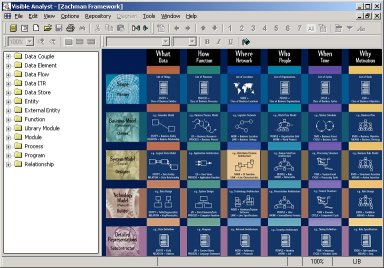Visible Analyst Enterprise Framework Edition
the most comprehensive modeling tool that Visible offers. It incorporates strategic planning, data modeling, object modeling, process modeling, and the Universal Model Framework, driven by an easy to use framework interface that allows straightforward navigation to all your model artifacts. The initial release of the Framework Edition supports the Zachman framework, with other frameworks slated for release in the near future.
Universal Model Framework
The Visible Analyst Enterprise Framework Edition leverages the power and repository of the Visible Analyst to applying an object-oriented approach to data modeling. The Visible Universal Model Framework attempts to fulfill the ideal of total model reuse through familiar objects and patterns. The key to this approach is to consider a model as constructed of reusable components; i.e., object classes. Every model contains fairly common object classes developed over and over again in different guises. By raising the level of abstraction we are able to generalize about the object classes and their relationships within a model - thus, the Visible Universal Model Framework.
The Visible Universal Model Framework is a high-level data model containing nearly fifty business subject areas or object classes and encompassing over 600 entities with 1,000 attributes. Each of the object classes is centered on a "kernel" entity. The kernel entities were established based on their relevance in the business environment. The object classes constructed around the kernel entity vary in complexity. The object class PERIOD, for example, consists of only 3 entities. Others, such as PERFORMANCE are very complex and consist of between 20 and 30 different entities.
The Visible Universal Model Framework also adds an additional frame of reference. Each object class may have one or more levels of abstraction based upon the business perspective from which the object class is viewed. For example, an entity viewed from a sales perspective will have different characteristics (attributes and associations) then the same entity viewed from a manufacturing perspective. The Visible Universal Model Framework is constructed with these different perspectives in mind.
- All businesses, even diverse businesses perform a set of common functions, e.g. Marketing, Sales, Research, Production, Purchasing, Human Resources, etc.
- Each business function performs many of the same activities, e.g. Contract Management, Contact Management, Document Management, Inventory Control, Budgeting, Accounting, Hiring, Training, etc.
- Many of the activities act on similar data, e.g. organizations, people, skills, products, services, facilities, locations, assets, liabilities, accounts, documents, etc.
- In many cases the similar data is in fact the same data, e.g. Mr. Jones, Ms. Smith, Washington DC, Dallas, etc.
